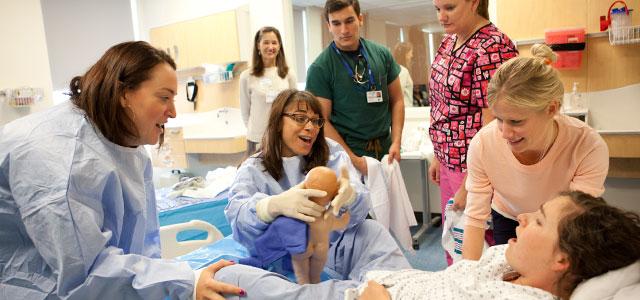
Students practice delivery both with “standardized patients” (live actors), as shown above at San Francisco General Hospital, and with robotic “simulated patients” at UCSF’s Kanbar Center, pictured in the linked slideshow (photos by Elisabeth Fall).
UCSF’s Nurse-Midwives Collaborate with Physicians for High-Quality Maternity Care
On a sunny day in late October, a group of midwifery graduate students from UC San Francisco School of Nursing and residents in obstetrics and gynecology from UC San Francisco School of Medicine sit in a windowless room in the UC San Francisco Kanbar Center for Simulation, Clinical Skills and Telemedicine Education talking about an emergency scenario they have just completed (see slideshow). Surprisingly, most of the discussion centers not on clinical skills or decisionmaking, but on communication: how physicians and midwives can engage in meaningful, respectful dialogue to improve patient care during the stressful, high-stakes events that are obstetrical emergencies.
Scenes like this one illustrate an increasing focus on interprofessional education that intersects with a collaborative model of maternity care between UC San Francisco’s certified nurse-midwives (CNMs) and obstetricians that began at San Francisco General Hospital (SFGH) and has evolved over almost 40 years to allow each to learn from one another and practice to their unique strengths, to the benefit of patient and provider alike.
Birth of a New Kind of Maternity Care in San Francisco
In the early 1970s, a group of obstetricians at SFGH began discussions with CNMs in the local community about starting what would become the first hospital-based midwifery practice in San Francisco. “They recognized that there was an untapped market for women who wanted midwifery care but didn’t want or couldn’t afford out-of-hospital birth,” says CNM Margaret Hutchison, a clinical professor in the Department of Obstetrics, Gynecology and Reproductive Sciences at the UC San Francisco School of Medicine, who also chairs the leadership council of the nurse-midwives of SFGH.
It was a time when attitudes toward childbirth were shifting. The enormous safety gains of the previous half century – a product of medical innovations like antibiotics, safer anesthetics and better diagnostic tools – had made survival of the mother and baby seem almost a given, but it moved maternity care into a more “medicalized” model, which sometimes ignored the fact that childbirth is a normal physiological experience for most women. In-hospital midwifery care strikes a balance between preserving the normal aspects of birth and providing rapid access to technology and advanced care when it’s needed.
The midwifery service at SFGH began in 1975 with the opening of an alternative birth center within the hospital, which offered a more homey environment than the traditional labor and delivery unit. Although births at the hospital increased by 50 percent in the first year, maintaining a separate unit proved financially unviable, and midwifery patients were eventually moved to the regular labor and delivery unit, where 46 percent of women now select a midwife for their care.
Changing the Culture of Childbirth at SFGH
The move proved fortuitous. Nurse-midwives and obstetricians began working side by side, and over time, a collaborative atmosphere developed.
“I think the early presence of midwifery at SFGH has influenced the culture of childbearing for everybody in our labor and delivery unit,” says Hutchison. Obstetrician Rebecca Jackson, chief of the SFGH division of the Department of Obstetrics, Gynecology and Reproductive Sciences, agrees. “[The midwives] push us [obstetricians] to think more carefully about why we do certain things,” she says.
An early example of such rethinking was the practice of episiotomy (a cut made in the perineum during delivery). In the 1970s, the procedure was still the standard of care among obstetricians, who believed that a controlled cut would be easier to repair and would heal better than a natural tear. Midwives, however, did not use it routinely, and between 1976 and 1994, the episiotomy rate for spontaneous vaginal deliveries at SFGH fell from over 86 percent to just over 10 percent. In a 1989 study of perineal outcomes, a pair of SFGH obstetricians wrote that midwives had influenced the department’s episiotomy policy and that they might be considered the “true experts in managing the ‘perineal stage’ of labor.” Subsequent research has shown that routine episiotomy offers occasional but limited benefit while increasing the risk of severe tearing into the rectum, and it is no longer recommended as standard practice.
Differing Approaches to Pregnancy and Birth
CNMs and obstetricians share a common goal of healthy mothers and babies, but they approach pregnancy and childbirth from slightly different perspectives. While obstetricians often view it through a preventive lens, favoring early intervention for potential problems, midwives tend to see it as a normal physiological process that works best when intervention is limited to what is necessary (a determination that is not always clear). An illustration of this differing approach can be found in practices surrounding augmentation (using medications and procedures to speed labor), says Jackson. “[Obstetricians] are much more likely to push a labor along when it starts to be longer than we think it should be. You have to convince us that it’s okay not to do it.” Midwives, says nurse-midwife Jenna Shaw-Battista, associate professor in the School of Medicine and director of both the interprofessional education grant and the UCSF/SFGH Interdepartmental Nurse-Midwifery Education Program, are more likely to recognize a wide range of “normal” lengths of labor; she notes that studies show that longer labors do not typically result in problems for mother or baby in the absence of other complications.
This difference in approach likely stems from the way obstetricians and midwives are educated, with physicians steeped in the “disease model” of care and midwives in the “normal physiological birth” model from the start of their training; these philosophical approaches to maternity care can become entrenched when there is little exposure to other models or opportunity for interprofessional collaboration. Many obstetricians and CNMs have never worked together, and it’s even rarer for them to have worked together in a setting that puts both clinicians on an equal professional footing.
UCSF’s training programs for nurse-midwives and physicians aim to change that.
Increasing Opportunities for Interprofessional Education
When it accepted its first students in 1977, the UC San Francisco nurse-midwifery certificate program was housed within the School of Medicine’s Department of Obstetrics, Gynecology and Reproductive Sciences at SFGH, putting CNM faculty together with medical faculty, which provided an early opportunity for interprofessional education and clinical collaboration. In 1988, the SFGH certificate program partnered with the School of Nursing to offer a master’s of science degree in nursing, and was co-housed in the schools of medicine and nursing until 2011, when it was moved to the School of Nursing’s Department of Family Health Care Nursing (FHCN).
Several CNM professors remain on faculty at the School of Medicine, and the commitment to interprofessional education has expanded with the increased recognition of its potential benefits. A $1.1 million interprofessional education grant from the federal Health Resources and Services Administration’s Advanced Nursing Education program is funding the Interprofessional Care of Childbearing Families project, which is administered through the School of Nursing’s FHCN; it partners midwives and physicians from the School of Medicine and SFGH. Grant activities allow advanced practice students in midwifery, women’s health and pediatrics, as well as medical students and residents in obstetrics, pediatrics and family medicine, to participate in experiences that foster teamwork and collaboration to increase patient safety and improve perinatal care.
Among the key simulations are obstetric emergencies, normal physiologic births and obstetric ultrasound tests, which allow students and residents to role-play real-time events and experience scenarios from various perspectives. Research suggests that simulations like these can have a positive impact on team functioning and patient safety, says Shaw-Battista. “It improves team communication and understanding of the various scopes of practice, and also helps clarify values and assess learners’ pre-existing attitudes and beliefs about the other professions.”
This year for the first time, midwifery students will be included in the “Life Cycles” course required for all medical students. “That’s fantastic,” says Shaw-Battista, “because medical and midwifery students will eventually practice together, and if we educate them together, they practice more efficiently and safely.” The course will include midwifery content on normal physiologic birth, such as the newly recognized benefits (including increased iron stores and reduced risk of iron-deficiency anemia in infants) of delayed cord clamping – evidence that originated in nurse-midwifery research. It will also introduce the practice of group prenatal care, an evidence-based model of peer health education and clinical care that midwifery students and medical residents at UCSF and SFGH participate in as part of the midwife-led CenteringPregnancy program.
In addition, as part of the grant, an elective course for medical students, called U-Teach, which has long been led by CNM faculty at the School of Medicine, has been revised to emphasize interprofessional education and this year for the first time includes midwifery students. Students attend a series of lectures about prenatal and maternity care, after which each is assigned to follow a childbearing family throughout pregnancy, birth and the postpartum period. In the revised course, midwifery students follow families that have chosen obstetric care, and medical students follow families that have selected midwifery care.
Leveraging Obstetric and Midwifery Expertise
Part of the rationale for including midwifery concepts and practices in medical education is to provide future physicians with more exposure to normal physiologic birth than they have had in the past few decades. “We are realizing that unnecessary technologic intervention is not only costly, but can result in a cascade of other interventions that ultimately does not improve outcomes and can even worsen them,” says Shaw-Battista. Participating in more births that are allowed to proceed without intervention can give students a better picture of what’s normal and what’s not.
Similarly, midwives benefit from the expertise of obstetricians. While CNMs view birth as a normal process, they must be as vigilant as obstetricians in identifying the abnormal and intervening – or consulting or referring to an obstetrician if necessary – when the health of mother or baby is threatened. In addition to the normal physiological birth and obstetric emergency simulation courses, UCSF midwifery students are now learning some advanced competencies alongside medical students and residents, such as limited obstetric ultrasound, taught by Shaw-Battista and obstetrician and geneticist Juan Vargas, medical director of obstetrics at SFGH. The course has also been extended to practicing midwives and family practice physicians. “The hope is that by providing opportunities to learn together interprofessionally, we can better integrate research evidence into the classroom and clinic to reduce both preventable complications and unnecessary interventions – and improve outcomes,” says Shaw-Battista.
Breaking Down Barriers for Better Patient Care
Such efforts illustrate one of the key goals of interprofessional education: increasing patient safety by breaking down the impediments to effective communication and collaboration. That has been the focus since the early adoption of a collaborative model of maternity care at SFGH, through today’s efforts to expand interprofessional education across UCSF.
While SFGH maintains an independent midwifery service, allowing patients to choose either a physician or a CNM for care, midwives at the UCSF Medical Center are integrated into a faculty practice that mixes obstetricians and nurse-midwives. Patients can select a midwife or an obstetrician for their prenatal care, but because there is not 24/7 midwifery coverage at the medical center, obstetricians and midwives share responsibility for the deliveries, and who attends a birth will depend on who is on call when a laboring woman comes in.
Nevertheless, says Suzanne Seger, a CNM at the UCSF Medical Center and associate professor in the Division of Maternal-Fetal Medicine, women who deliver at the medical center can have low-intervention care if they want it, thanks in part to the interprofessional education and collaboration that occurs across UCSF.
“It was really appealing to me,” says Seger, who came to UCSF from New York eight years ago. “Prior to coming here, I found there was a really clear delineation between midwifery patients and physicians’ patients, and it would sometimes impact patient care in a way that made me nervous. There wasn’t a good sharing of expertise.”
In contrast, she says, the equal sharing of responsibility and authority at UCSF Medical Center translates into teams that function more effectively in a variety of ways.
Consider those patients who would prefer to deliver with a midwife, but who develop complications either before or during labor that require the expertise of a maternal-fetal medicine specialist. In the UCSF model, midwives can often continue to co-manage these women’s care. The benefits begin with reduced potential for medical errors and less duplication of services – important factors in the “triple aims” era of health care reform.
In addition, a midwife can help preserve the “normal” aspects of pregnancy and birth even for a woman who needs lots of intervention to bring her baby safely into the world. For example, midwives will often suggest delivering a preterm infant in a bed rather than in the operating room, or she might suggest turning down the lights for a nonsurgical birth that has to take place in the operating room.
Preserving “normal” in these ways can help patients feel more in control of their situation, which improves patient satisfaction, and research suggests that it may help protect women who have complex deliveries from postpartum depression. Seger relates the story of a patient who had a rare medical condition and knew she would be delivering in an operating room with an obstetrician and lots of interventions. “She’d been in and out of the medical system all her life, but she didn’t want to be regarded as unusual when it came to her pregnancy,” Seger says. She worked with a high-risk obstetrician to create a management plan that allowed her to participate in the CenteringPregnancy program, something that was important to her, while still receiving the expert care she needed.
A National Push for Collaborative Maternity Care
While interprofessional collaboration may not always have the deep roots that it has at UCSF, it is gaining traction nationally as a way to improve quality, increase access to maternity care and reduce the cost of care. In 2010, the American College of Nurse-Midwives (ACNM) and the American College of Obstetricians and Gynecologists inaugurated a formal partnership to examine the relationship between obstetricians and nurse-midwives and seek ways for them to work together to improve patient care. Among the fruits of that partnership was a joint statement issued in 2011 on the importance of access to collaborative care; the opportunity for leaders of each group to participate in high-level meetings of their respective organizations; and the Successful Models of Collaborative Practice in Maternity Care project, which invited maternity care teams to submit papers describing working models of collaborative practice. Four were selected from among 60 submissions for publication in the September 2011 issue of ACOG’s journal, Obstetrics and Gynecology, among them “Great Minds Don’t Think Alike: Collaborative Maternity Care at San Francisco General Hospital,” a paper co-authored by Hutchison, Shaw-Battista, Jackson and other UCSF faculty in which they describe the successes and challenges of the maternity care model at SFGH.
Challenges for Collaboration and Access to Care
One barrier to expanding truly collaborative – rather than top-down – care is the regulatory climate for CNMs in California. Despite a body of evidence that suggests that CNMs have outcomes that are as good as physicians’ – and better for some measures, such as perineal tears and breastfeeding initiation – California is among a handful of states that continue to require physician supervision of CNMs. This means that physicians continue to have some legal responsibility for the patients of midwives they nominally supervise, even if they are not directly involved in a patient’s care. The law does not require direct supervision.
“I tell my residents that we are responsible for every patient that steps into the labor and delivery unit, legally and ethically,” says Jackson. This makes good communication even more important because disagreement over care can have serious ramifications for all providers.
While the close collaboration between physicians and midwives at UCSF and SFGH provides women in the San Francisco Bay Area with choices about their maternity care, some believe the state’s supervision requirement creates a barrier to choice, and to access to skilled maternity care, for women outside urban areas. Much of the state is rural, and in areas with a shortage of obstetricians, the supervision requirement makes it difficult for nurse practitioners and CNMs to fill the void. Because of the way hospitals are accredited, CNMs in states with regulations like California’s are prohibited from admitting patients to hospitals for delivery without a physician’s order; moreover, CNMs can’t attend home or birth-center births without a formal agreement with a sponsoring physician without risking penalty for noncompliance with the regulation. Physicians are often reluctant to enter these agreements due to liability concerns. (Ironically, while supervision requirements remain in place for California’s CNMs, Governor Brown recently signed AB 1308, which removed the supervision requirement for non-CNM midwives to attend out-of-hospital births. The bill was sponsored by ACOG’s California chapter as a way to ensure that families who want out-of-hospital birth have access to trained birth attendants by removing barriers to practice for non-CNM midwives, who attend the majority of these births.)
Flattening the Hierarchy for Better Communication
Among the most significant challenges to implementing collaborative care is simply lack of experience with it. In addition to a dearth of interprofessional educational opportunities, the historically strong hierarchy in health care that has put nurses and midwives under physician supervision has stymied efforts at creating a more egalitarian culture. There is a push across health care professions to flatten that hierarchy, because doing so encourages open discussion and a more careful examination of policies that can negatively affect both clinician satisfaction and health care outcomes.
“We want [everyone on the team] to be able to intervene proactively,” says Jackson. “We want the nurse to be able to say to the midwife, ‘I’m worried about this,’ and for the nurse or midwife to go to the attending physician to bring up problems, and vice versa.”
This has worked well at SFGH, says Jackson, because UCSF’s midwives are good at communication and giving feedback to both students and experienced clinicians. Moreover, she’s seen improvement in patient care that she attributes to the interprofessional simulations that have taken place. In the past, debriefings after emergencies almost always identified problems with communication and a lack of clarity about team members’ roles. “That’s changed remarkably,” says Jackson.
Resolving Conflicts to Provide More Choice
Even with collegial relationships and good communication, there are conflicts, but a collaborative model helps ensure that these are resolved before they reach a crisis point. For example, when ACOG released a 2007 statement recommending that women with premature rupture of membranes at term have labor induced immediately, some obstetricians at SFGH became uncomfortable with midwives continuing to offer expectant management (waiting at least 24 hours for labor to begin on its own unless other problems arise). The two groups worked together to create a guideline – based on the best available research – that allowed midwives to continue to support expectant management in a carefully selected group of healthy women, after informed consent discussions.
Examples like this highlight the way close midwife-obstetrician collaboration can offer families choices that are important to them while minimizing the risks inherent in pregnancy and childbirth.
“The future focus for midwifery,” says Kim Q. Dau, CNM at SFGH and assistant director of the UCSF nurse-midwifery education program, “should be to continue to integrate into the system of collaborative maternity care and define the standard of care for healthy women.”



